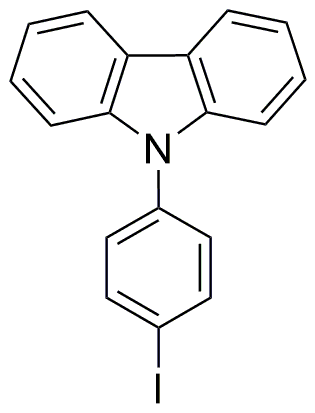9-(4-Iodophenyl)carbazole is widely utilized in research focused on:
- Organic Electronics: This compound is used in the development of organic light-emitting diodes (OLEDs), enhancing device efficiency and color purity.
- Photovoltaic Cells: It serves as a key material in organic solar cells, improving light absorption and energy conversion rates.
- Fluorescent Sensors: The compound is employed in creating sensors for detecting environmental pollutants, offering high sensitivity and selectivity.
- Pharmaceutical Research: It is explored for its potential in drug design, particularly in targeting specific cancer cells due to its unique structural properties.
- Material Science: This chemical is used in the synthesis of novel polymers, contributing to advancements in flexible electronics and high-performance materials.
Información general
Propiedades
Seguridad y normativas
Aplicaciones
9-(4-Iodophenyl)carbazole is widely utilized in research focused on:
- Organic Electronics: This compound is used in the development of organic light-emitting diodes (OLEDs), enhancing device efficiency and color purity.
- Photovoltaic Cells: It serves as a key material in organic solar cells, improving light absorption and energy conversion rates.
- Fluorescent Sensors: The compound is employed in creating sensors for detecting environmental pollutants, offering high sensitivity and selectivity.
- Pharmaceutical Research: It is explored for its potential in drug design, particularly in targeting specific cancer cells due to its unique structural properties.
- Material Science: This chemical is used in the synthesis of novel polymers, contributing to advancements in flexible electronics and high-performance materials.
Documentos
Hojas de datos de seguridad (HDS)
La SDS proporciona información de seguridad completa sobre la manipulación, el almacenamiento y la eliminación del producto.
Especificación del producto (PS)
La PS proporciona un desglose completo de las propiedades del producto, incluida la composición química, el estado físico, la pureza y los requisitos de almacenamiento. También detalla los rangos de calidad aceptables y las aplicaciones previstas del producto.
Certificados de análisis (COA)
Busque certificados de análisis (COA) ingresando el número de lote del producto. Los números de lote y de partida se pueden encontrar en la etiqueta de un producto después de las palabras "Lote" o "Lote".
Número de catálogo
Número de lote/lote
Certificados de origen (COO)
Este certificado de origen confirma el país en el que se fabricó el producto y también detalla los materiales y componentes utilizados en él y si se deriva de fuentes naturales, sintéticas u otras fuentes específicas. Este certificado puede ser necesario para cumplir con las normativas aduaneras, comerciales y regulatorias.
Número de catálogo
Número de lote/lote
Hojas de datos de seguridad (HDS)
La SDS proporciona información de seguridad completa sobre la manipulación, el almacenamiento y la eliminación del producto.
DownloadEspecificación del producto (PS)
La PS proporciona un desglose completo de las propiedades del producto, incluida la composición química, el estado físico, la pureza y los requisitos de almacenamiento. También detalla los rangos de calidad aceptables y las aplicaciones previstas del producto.
DownloadCertificados de análisis (COA)
Busque certificados de análisis (COA) ingresando el número de lote del producto. Los números de lote y de partida se pueden encontrar en la etiqueta de un producto después de las palabras "Lote" o "Lote".
Número de catálogo
Número de lote/lote
Certificados de origen (COO)
Este certificado de origen confirma el país en el que se fabricó el producto y también detalla los materiales y componentes utilizados en él y si se deriva de fuentes naturales, sintéticas u otras fuentes específicas. Este certificado puede ser necesario para cumplir con las normativas aduaneras, comerciales y regulatorias.


